 An interim cap over the tank farm at the Idaho Nuclear Technology and Engineering Center serves to channel water away from the site to protect the underlying Snake River Plain Aquifer.
IDAHO FALLS, Idaho –Two EM organizations in Idaho are effectively working together to manage water at a Cold War-era facility at the Idaho National Laboratory (INL) Site to protect the underlying aquifer used by 300,000 Idaho residents for agriculture, drinking water and municipal usage.
EM contractor Idaho Environmental Coalition’s (IEC’s) Environmental Restoration (ER) and Infrastructure organizations teamed up to investigate water leaks and manage rain and snowmelt at the Idaho Nuclear Technology and Engineering Center (INTEC), which reprocessed spent nuclear fuel from the early 1950s until 1992. Because the facility stores radioactive and hazardous waste and some of that waste has contaminated underlying soil through historic releases, the effort is imperative to prevent water from moving through the contaminated soil toward the underlying Snake River Plain Aquifer.
At INTEC, water diversion is focused in and around the Tank Farm. The Tank Farm is a collection of underground storage tanks that accepted and transferred high-level liquid radioactive waste generated from reprocessing activities. Historic leaks in piping and valve boxes contaminated the soil beneath the Tank Farm. Since then, all but four tanks have been emptied, cleaned and grouted. A 10-acre asphalt pad and water diversion system were later installed.
ER and Infrastructure maintain the asphalt pad and the stormwater drainage system that diverts all runoff to the INTEC Evaporation Pond, a lined pond east of the facility. Workers conduct quarterly inspections, drainage cleanouts and preventative maintenance on the lift station pump and the pond’s leak detection system. In 2021, ER purchased asphalt maintenance equipment to conduct periodic repairs on the pad.
Water diversion below the surface pertains to the contaminated water body – a saturated zone of soil and rock between the ground surface and the top of the aquifer. ER and INTEC workers monitor the facility’s water utility systems to identify when a pipeline leak occurs, isolate the leak and repair the system as soon as possible. A network of situated water monitoring wells also are used to identify the location of pipeline leaks and to monitor the contaminants of concern on an annual basis. Most recently, flow-metering upgrades have been completed on the firewater, raw water and the potable water systems to improve monitoring.
“In the last dozen years, crews have identified more than 80 water discharges from the facility and made repairs to stop those discharges,” said IEC environmental scientist Sarah Thompson.
The INL receives an average of about nine inches of rain and snow annually, and where that water flows at INTEC is crucially important.
“We’re having very good success and are constantly making improvements,” said Thompson. “The aquifer directly benefits from our work.”
-Contributor: Erik Simpson
 Graduates of EM contractor Central Plateau Cleanup Company’s first health physics technician training course, from left, are Mariah Movick, Sydney Hall, Bella Balderman, Jay Daffe, Alex Loomis, Ryan Cantwell, Nadia Barbarosh, Makenna Monroe, Brad Scott, Presten Savage, Travis Roos, Drake Grieder, Ian Olexa (kneeling), Shanna Seholm, Lealene Quiambo, Dana Young (kneeling), Brittany Robertson and Piper Vucelick.
RICHLAND, Wash. – A comprehensive health physics training program is not only reinforcing radiation safety but also building the next-generation workforce at the Hanford Site.
EM Richland Operations Office contractor Central Plateau Cleanup Company (CPCCo) began a 17-week health physics course earlier this year to provide robust training supporting the site’s ongoing environmental cleanup mission. Once certified, the health physics technicians, or HPTs, are the radiation safety “police,” ensuring that any potential radiological hazards are identified and properly managed to protect workers, the public and the environment.
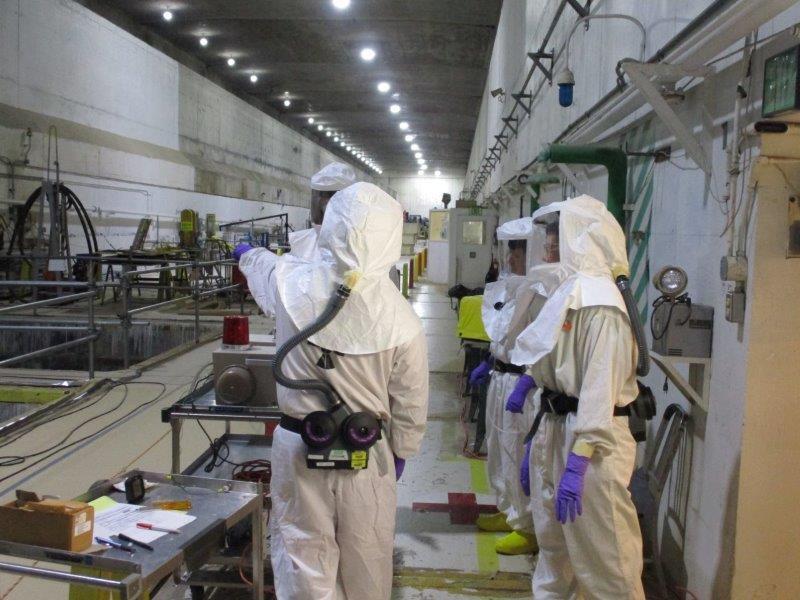 After completing EM contractor Central Plateau Cleanup Company’s 17-week health physics course, participants continue on-the-job training for an additional six months before they can test to become certified as health physics technicians at the Hanford Site.
“A robust health physics program is vital to a healthy safety culture,” said Glyn Trenchard, Office of River Protection assistant manager for Safety and Environment. “It is critical to ensuring the safe deactivation and decommissioning of nuclear facilities on the Hanford Site.”
Students in the HPT training course learn how to calculate radiation doses, estimate the potential risk of exposure and interpret data from radiation detection instruments. Coursework also includes site-specific information such as Hanford’s safety culture, documentation and emergency response. Students also complete four weeks of practical hands-on training at the nearby Volpentest HAMMER Federal Training Center.
“HPTs play a critical role in the work we do at Hanford, and getting certified involves a lot of education and training,” said Roy Lightfoot, CPCCo radiological protection manager. “Whether they have previous nuclear experience or not, HPT students learn about the job from the ground up; everything from isotopes to safety culture to federal regulations to the history and evolution of radiological control.”
Students who pass the HPT test at the end of the initial course begin rotations as trainees at CPCCo projects across the Hanford Site. Graduates will continue to receive on-the-job training for another six months before they are eligible to become certified HPTs.
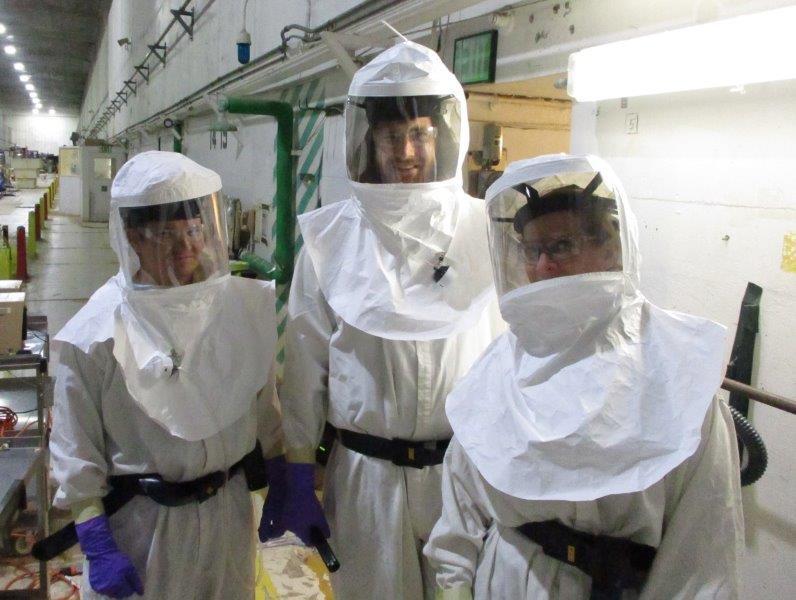 |
|
From left, Travis Roos, Brad Scott and Piper Vucelick visit T Plant during their rotations as part of EM contractor Central Plateau Cleanup Company’s health physics training program on the Hanford Site. |
“Taking the HPT training changed some goals in my life,” said Ian Olexa, a recent graduate of the course. “I did something completely out of the norm that I never thought I could do. It’s a really good opportunity to support an important mission.”
Based on the success of the course, CPCCo launched another course this spring.
-Contributor: Karisa Saywers
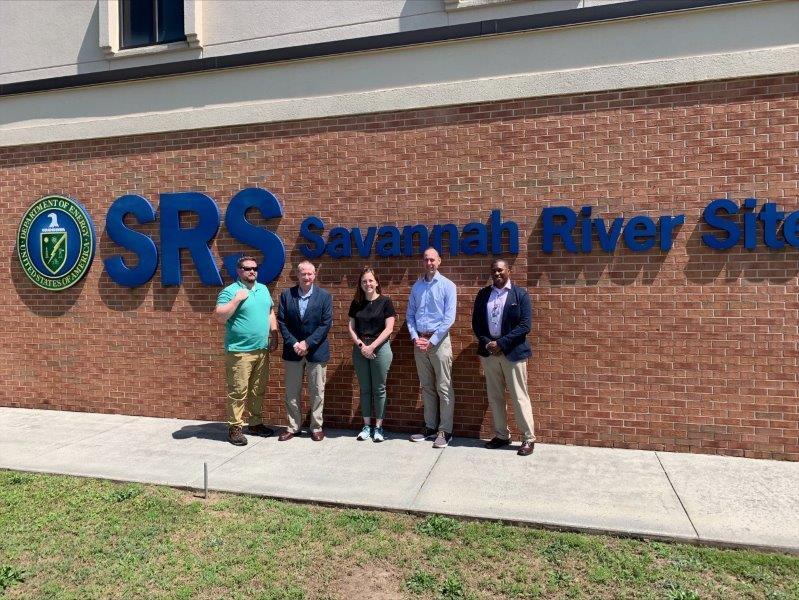 AIKEN, S.C. – Members from the U.S. Senate Committee on Armed Services and other government agencies toured National Nuclear Security Administration (NNSA) and Department of Energy EM facilities at the Savannah River Site last week. Pictured, from left, are Adam Trull and Jonathan Epstein with the Senate Armed Services Committee (SASC) professional staff, Jessica Lewis, detailee to SASC for the Government Accountability Office, Capt. Dave Payne with the U.S. Navy Office of Legislative Affairs, and Travis Williams with NNSA Congressional Affairs.
 Industrial Safety Representative Miranda Kennedy discusses mental health awareness at a recent Women's Employee Resource Group meeting, part of a broader effort by the contractor to encourage discussion about mental wellness.
OAK RIDGE, Tenn. – When considering risks associated with nuclear cleanup, many people would list radiation, chemicals or falling debris. While correct, an Oak Ridge Office of Environmental Management cleanup contractor is taking another step to consider an additional important safety factor – the mental health of employees.
United Cleanup Oak Ridge (UCOR) has implemented a new program, titled Navigate, as a component to its behavioral, physical and mental health program. Navigate is designed to educate and assist employees through the development of trust, open communication and normalizing mental health conversations.
Mental health first aid training, which teaches participants how to identify and respond to signs of mental health issues, is in development and will be deployed across the work sites. It also will enable peer-to-peer identification of employees who may be experiencing issues.
“We are not only building a resiliency program to help strengthen mental health awareness company wide, but we are also creating a process to provide help to those who are in need of immediate mental health assistance via those who are closest to the point of care,” said Dr. Grant Shirley, UCOR’s occupational medical director.
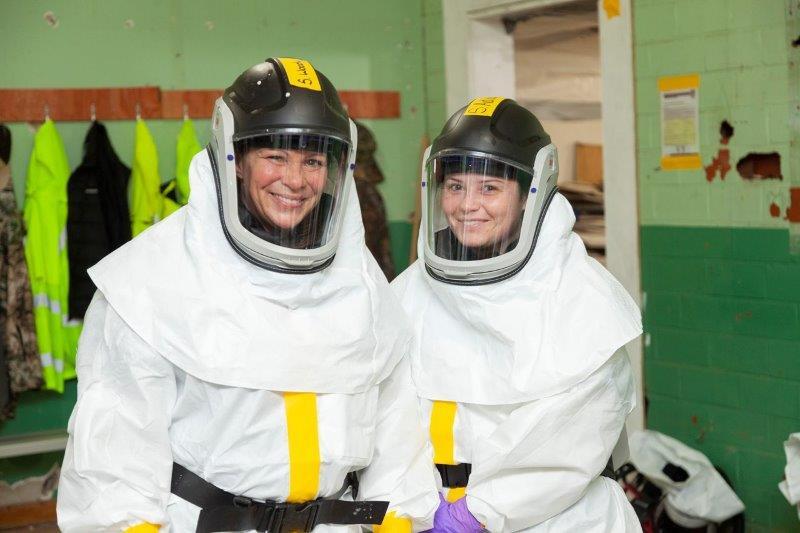 When entering old, contaminated buildings, it’s important to account for all of the external risks, but it’s equally as important to be in the right mindset to perform the tasks at hand. UCOR is implementing a program to do just that. Pictured, from left, are deactivation workers Susan Woody and Stephanie Adkins.
According to the Centers for Disease Control and Prevention, the construction industry has one of the highest suicide rates by population – about four times higher than the general population.
“Since UCOR’s work generally falls into the construction category, we want to ensure we are proactively providing our employees with the right set of tools to facilitate achieving a high level of mental wellness,” said Katie Pinkston, UCOR wellness coordinator.
The contractor is implementing this focus for its entire workforce, especially those who may have difficult circumstances at home.
“Mental, physical and behavioral health all play a role in total worker health,” Pinkston said. “If one of the areas is ignored, the other two may suffer.”
UCOR already has a robust physical wellness program called Elevate. However, to continually grow and challenge the status quo, leadership determined that a separate, related program was needed to specifically address mental health within the organization.
“We have a lot of activities planned that will get employees thinking and talking about mental health,” Pinkston said.
There are plans to offer numerous mental health resources that will provide awareness, training, and educational and engagement activities.
Additionally, UCOR is partnering with other organizations. Leadership recently traveled to Iowa to consult with a large, private construction company that has a long-running, well-established behavioral and mental health program.
The new Navigate program also joins other initiatives designed to provide a supportive work environment such as an Employee Assistance Program, Employee Concerns Program and employee recognition programs designed to emphasize the value of employees.
May is Mental Health Awareness Month.
-Contributor: Wayne McKinney
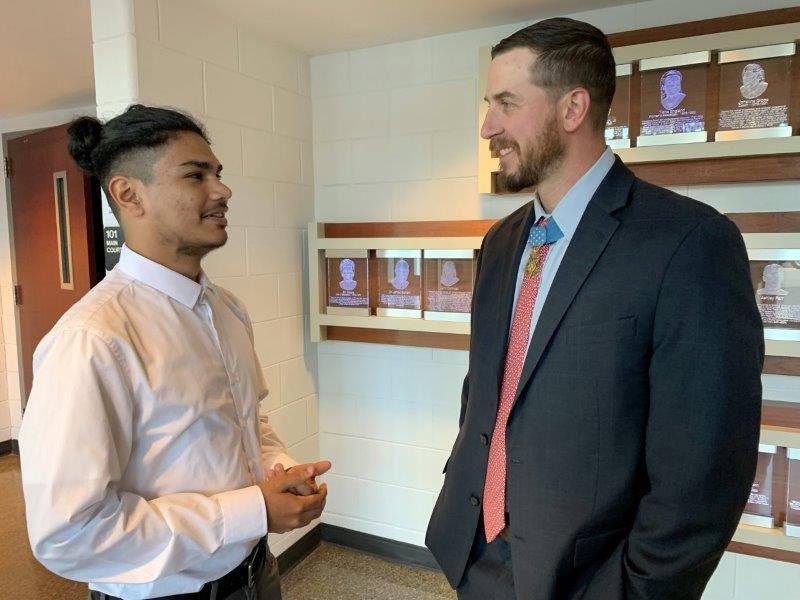 Midland Valley High School senior Christian Carrillo receives advice from Medal of Honor Recipient Sergeant Ryan Pitts, (U.S. Army, Airborne), at this year’s Our Community Salutes event honoring area students who have recently enlisted in the U.S. Armed Forces.
AIKEN, S.C. – The third annual enlistee recognition gala was recently held to honor area high school students who are graduating from academia to the military, choosing to serve and protect our country.
The event was hosted by Our Community Salutes (OCS) Midlands South Carolina Chapter, with the generous financial support of multiple sponsors. EM’s Savannah River Nuclear Solutions (SRNS) was the “Circle of Honor” top sponsor.
“We’re here to recognize and honor the impressively brave commitment these young men and women have made for us and also to provide their parents or guardians with community support as their son or daughter transitions into military service,” said Jim Foley, Chairman for OCS, a nonprofit organization. “All the veterans who came together to help form the Our Community Salutes Midlands Chapter experienced the same anxieties and challenges each enlistee attending today’s event now face after making the decision to join the military. And each had the same courage, the same guts to raise their right hand, sign those documents and take the oath.”
In addition to an impressive list of guest speakers, including the first female from South Carolina to hold the rank of Lt. Gen. Maria Gervais, the enlistees each were escorted by a member of the U.S. Armed Services, provided an excellent meal and presented with a specially minted challenge coin commemorating the occasion.
The keynote speaker for the evening was Medal of Honor Recipient Sgt. Ryan Pitts (U.S. Army, Airborne).
Pitts distinguished himself by extraordinary acts of heroism at the risk of his life above and beyond the call of duty during combat in Afghanistan. He chose to attend the event to honor the enlistees, provide advice and create a scholarship fund for the Veteran and Military Success Program at the University of South Carolina Aiken.
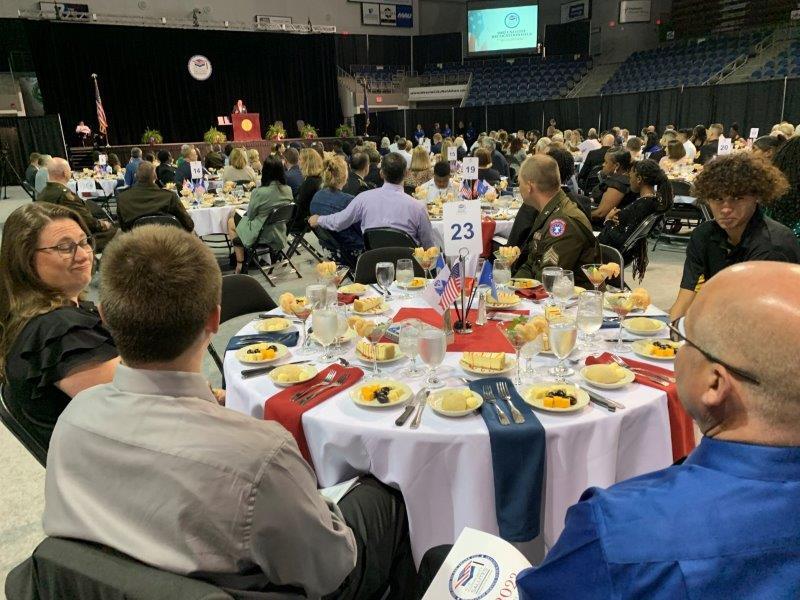 Jim Foley, chairman for Our Community Salutes, Midlands South Carolina Chapter, introduces keynote speaker and Medal of Honor Recipient Sgt. Ryan Pitts.
He began his presentation by describing the attack he and his fellow soldiers endured the night of July 13, 2008, in the vicinity of a tiny village in a highly mountainous region of the country.
“Valor was everywhere that day,” said Pitts. “And the real heroes are the nine men who made the ultimate sacrifice so the rest of us could return home. It is their names, not mine, that I want people to know.”
SRNS Senior Vice President Workforce Services and Talent Management Francine Burroughs, who attended the event, said she was impressed by the speakers and applauded the OCS Midlands South Carolina Chapter for the time and effort each member put in to ensuring a rewarding experience for the graduating students.
“I’m proud to have had the opportunity to witness and be a part of this ceremonial gala held for the benefit of each young adult who chose to step forward and say ‘Yes, I will go. I will defend this nation.’ We, as a company, support a wide range of educational and philanthropic needs throughout the region. We hope these young men and women carry with them, throughout their time in the military and beyond, the sage advice provided by tonight’s speakers,” said Burroughs.
-Contributor: DT Townsend
 Washington State University students test their tank-waste crust sampling devices at the Hanford Site’s Cold Test Facility as part of their senior projects.
RICHLAND, Wash. – Several new partnerships will help provide the workforce necessary for the future of the Hanford Site’s cleanup mission.
Employees with EM Office of River Protection (ORP) tank operations contractor Washington River Protection Solutions (WRPS) are fostering the next generation of professionals that will move the cleanup mission forward. WRPS engineers are working with Washington State University (WSU) to mentor students on tank waste mission-related projects.
“The Department of Energy (DOE) and its prime contractors are working to interest students in employment to support the crucial cleanup and closure operations at the Hanford Site and other locations across the DOE complex,” said Ricky Bang, ORP Tank Farms Program Division director. “This immersive method of engagement provides opportunities for students to contribute toward cleanup projects, see equipment and learn about how the complex operates as part of their studies.”
This spring semester, Washington State University (WSU) materials science majors from the Tri-Cities campus in Richland, Washington, developed a next-generation tank waste-level detector. The mobile unit can be attached to the top of an underground waste storage tank.
Another group of students from the main WSU campus in Pullman, Washington, developed a simulant and a sampler to identify floating crust layers in waste-storage tanks.
Deploying new tools to further the Hanford cleanup mission is important, but even more so is obtaining the talent that soon will develop and operate the equipment as industry professionals.
“Mentoring students through projects like these facilitates a real-world application of the concepts they’ve learned in class,” said Doug Reid, a WRPS mechanical engineer who served as company sponsor for the student projects. “It also familiarizes them with the Hanford tank-waste mission.”
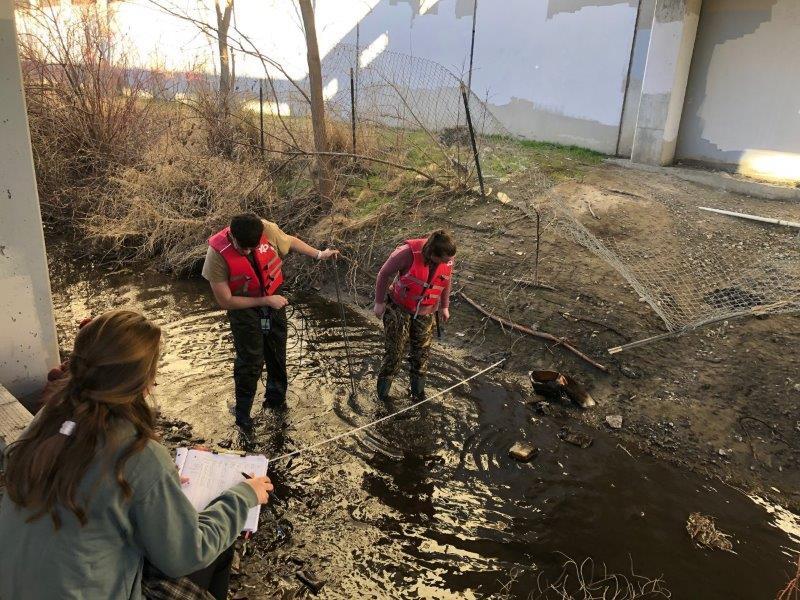 Washington State University students gain hands-on experience by taking measurements from a municipal stormwater system.
In yet another partnership, Michele Hendrickson, a WRPS engineer and WSU adjunct instructor, took a novel approach to leading a new laboratory course at WSU Tri-Cities. She learned that several Tri-Cities civil engineering students would need to regularly travel more than 100 miles to the WSU Pullman campus to take a required course, which could negatively affect their studies and abilities to work. Instead, she offered to teach the course at the Tri-Cities campus, where it has never been taught before.
When it became apparent the Tri-Cities engineering lab would not have all the necessary course equipment, Hendrickson got creative by working with other organizations to take the lab experience out into the real world. Students ventured under Richland bridges to monitor stream flow in the city. They also learned about water flow by using modeling software, and even visited a local engineering firm to see a turbine pump planned for installation at the Hanford Site.
“I really believe others were so willing to help because they understand the importance of bringing up the next generation of STEM professionals,” said Hendrickson.
-Contributor: Derek Miceli
|